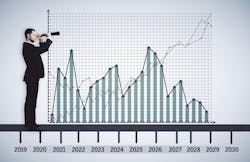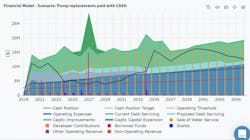About the author:
JP Joly is CEO and founder of Waterworth. Joly can be reached at [email protected]
Humans are visual creatures; from infancy to early childhood, pictures and visual cues are paramount to our understanding of iconic stories like The Cat in the Hat or Where the Wild Things Are.
As we get older, we become able to interpret and understand larger and more complex stories and abstract ideas — but the visuals remain, except now they are in our minds instead of on paper. This leads to a difference in interpretation of information, even when two people read the exact same reference.
In municipal government that also exists, and the information we now interpret includes large, complex data sheets filled with numbers and dates. This disparity is at the crux of a much larger issue: getting finance, public works and engineering departments, as well as city council, on the same page about capital funding plans. When it comes to the world of municipal water systems, these complications can ultimately delay much needed upgrades in operation and infrastructure.
The Complexities of Utility Finance Datasets
Local government departments often work in silos, with limited interactions — and thus, limited understandings of each others’ domains.
Part of the problem is that departments have different datasets and are concerned with different assumptions. Finance will likely view the world on an accrual basis whereas engineering will see the world on a cash basis. Even when departments do integrate their data together and reconcile their differences, communicating this aggregate model to management, council, and ultimately the public is yet another challenge.
It is one thing to jump through all the hoops of editing data for one scenario — say, increasing water rates by 5% over the next three years — but how do you determine how that stacks up, and affects other parts of your water system, if that metric were to be changed to 6%? What if it is over 7 years instead? Suddenly the utility is back at ground zero, trying to make the data work for a different scenario, and understand it all over again.
Even the most number-savvy finance director still has roots in being a visual creature. This might be the long-ignored key to inter-department communication issues, and elected officials’ hesitancy to approve requests, who only ever see the occasional summary of the issue when needed. The root of the issue is that complex information is not being communicated in a way that is best suited to collaborative planning and optimized decision making. Let’s change that.
3 Solutions to Improve Water Utility Finance Conversations
1. Use Tools That Encourage Collaboration
Finance, engineering, public works, and planning departments must work together to build a collective understanding of the financial reality at hand.
Unfortunately, Microsoft Excel does not often allow for that. One person may make changes to a cell, dataset, or formula, and suddenly several sheets are impacted, whether other contributors know or not. Mistakes happen, and if it is not caught instantly, that mistake might be impossible to retroactively find and fix.
While Excel may be the long-time industry standard for large datasets, that does not mean there are not better, more collaborative ways of working than what Excel is capable of, even today. Using online or cloud-based systems allows for multiple users and real-time updates that encourage activity and collaboration from multiple parties — not just the designated “Excel wiz” of the group. More collaboration means improved productivity.
2. Shift to Continuous Planning & Dynamic Modeling
Engaging in continuous planning can efficiently guide your utility’s conversations over the months and years.
A tool that is easy to update means a utility can effortlessly stay on top, even when the landscape changes. Such a tool is crucial to solving the issue of long turn-around times when changes to the data are requested. Using a model that is dynamic also forecasts what those changes mean to a utility’s resilience, today and into the future.
With new information, one can make the necessary incremental changes, rebalance cash position towards policy guidelines, and check for any new impacts to rates, without having to sacrifice valuable time and effort. The flexibility of a dynamic model that can be adjusted and support multiple different real and hypothetical scenarios, saves finance and utility managers from having to say, “I’ll get back to you on that” and go back to their spreadsheets and tweak data, just to see if that scenario is feasible.
Being able to easily alter data points in-the-moment and compare multiple scenarios side-by-side allows anyone who works within the water system to gain better clarity on the task at hand. Continuous planning will elevate confidence that the right things are getting done and that the utility is on track for long-term financial sustainability.
3. Visualize Data to Tell a Story
While some of the issues currently faced by municipal utility staff lie in their analysis tools themselves, there is still the issue of interpretation of whatever the Excel model or program of choice shows the user.
One way to make this data easier to talk about and share is through visuals. Even the most complicated situations can be simplified through the use of graphics, whether the includes charts, graphs, or animations. By presenting data visually, the mind can quickly grasp the sensitivities and how much changing one parameter can affect another. Additionally, using visuals on top of scenario modeling is a great way to communicate to all stakeholders.
As has been emphasized, humans are visual creatures. We have an innate desire to find visual patterns and designs to help make sense of the world around us. Capitalizing on this basic human wiring by using visual elements will allow even the most complex of messages to be communicated more clearly and effectively. By bringing up the level of understanding of the whole group, better conversations are facilitated and that should lead to smarter decisions, and quicker approvals.
A Path to Better Finances
The status quo is that, whether in part or in whole, a lack of good communication leads to important decisions being deferred. And in the meantime, a lot of people’s time and effort is wasted.
Outdated, basic-yet-overly-detailed tools are no longer the reality that municipalities have to deal with, yet continue to do so out of comfort or habit, even if it comes with a plethora of hassle and hurdles. A utility can keep the depth of their water system’s data sets, without the complexity of dealing with spreadsheets.
A collaboratively created, robust scenario-driven model will help systems ensure they have funds when they need them, and accompanying visual graphics will help communicate that to who needs to understand it.



